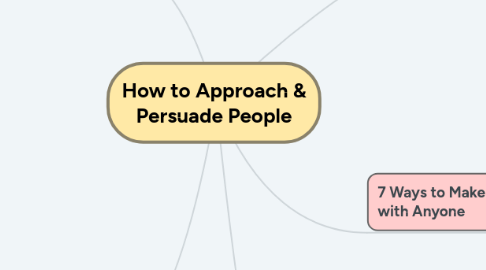
1. How to Manipulate Emotions
1.1. Cue Response Systems
1.1.1. Where we find these cue response systems?
1.1.1.1. Anchoring or Conditioned Response
1.1.1.1.1. an anchor refers to any specific cue that elicits a predictable response.
1.1.1.1.2. Two secrets
1.1.2. How they work?
1.1.2.1. A specific cue will elicit a specific response
1.1.2.1.1. Positive affect
1.1.2.1.2. Negative affect
1.1.3. How we can make these cue response system work for ourselves?
1.1.3.1. 5 Step Anchoring Plan
1.1.3.1.1. 1. Decide on a stimulus & a state
1.1.3.1.2. 2. Vividly imagine the state
1.1.3.1.3. 3. Step inside this daydream
1.1.3.1.4. 4. Apply your stimulus
1.1.3.1.5. 5. Test, use, and enjoy the anchor
2. The Psychology of Seduction
2.1. How to seduce
2.1.1. When other people think they had an impact on you, they think they warmed you up.
2.1.1.1. There is something about having an impact which is very seductive
2.1.2. 3 key phases of relationships
2.1.2.1. Attention
2.1.2.2. Interest
2.1.2.3. Maintenance
2.1.3. a seduction is when you meet someone who is disinterested in you, and you convert that interest into rabid desire
2.1.3.1. Do or give something that someone specifically needs/ wants
2.1.4. Fill the unmet need
2.1.4.1. find someone's unmet need and fill it in a way it's never been filled before
3. We have to make the conversation memorable
3.1. How do you do it?
3.1.1. Skip the small talk and ask a really personal question
3.1.1.1. Name
3.1.1.2. Family
3.1.1.3. Experience
3.1.1.4. Hobby, etc.
4. 7 Ways to Make a Conversation with Anyone
4.1. 1. The First Word Flood Gates
4.1.1. The first word; just say it.
4.1.2. The first word acts as a floodgate. Once you said the first word, everything else just flows.
4.1.3. Make a big smile and say, "Hi!"
4.2. 2. Skip the Small-Talk
4.2.1. The Challenge in Communication : Time
4.3. 3. Find the "Me too"s
4.3.1. Don't start a conversation with a debate
4.3.2. Find the one thing that you and that other person might have in common. Then, start the conversation from there.
4.4. 4. Pay a Unique Compliment
4.4.1. "People will forget what you do, and they'll forget what you say, but they will never forget how you made them feel." - Maya Angelou
4.4.2. Be generous, give someone a nice full compliment.
4.4.2.1. Pay a unique and genuine compliment.
4.5. 5. Ask for an Opinion
4.5.1. Just ask something simple. Keep it generic.
4.5.2. When they give you an opinion : really listen!
4.6. 6. Be Present
4.6.1. Pay attention to someone
4.6.1.1. When someone's trying to communicate with you, you really have to be in that conversation.
4.6.2. Make eye contact
4.7. 7. Name, Place, Animal, Thing
4.7.1. Remember the little details about a person
4.7.2. Be genuinely interested to other people
5. The Science of Flirting : Being a H.O.T. A.P.E.
5.1. Humour
5.1.1. a shared sense of humour is important for helping you to differentiate between those who match with you and those who don't.
5.2. Open body Language
5.3. Touch
5.3.1. touch has a positive physiological response on our body
5.4. Attention
5.4.1. the more attention someone is paying you, the more they like you
5.5. Proximity
5.5.1. used in two ways
5.5.1.1. Pre-interaction
5.5.1.2. In the interaction

